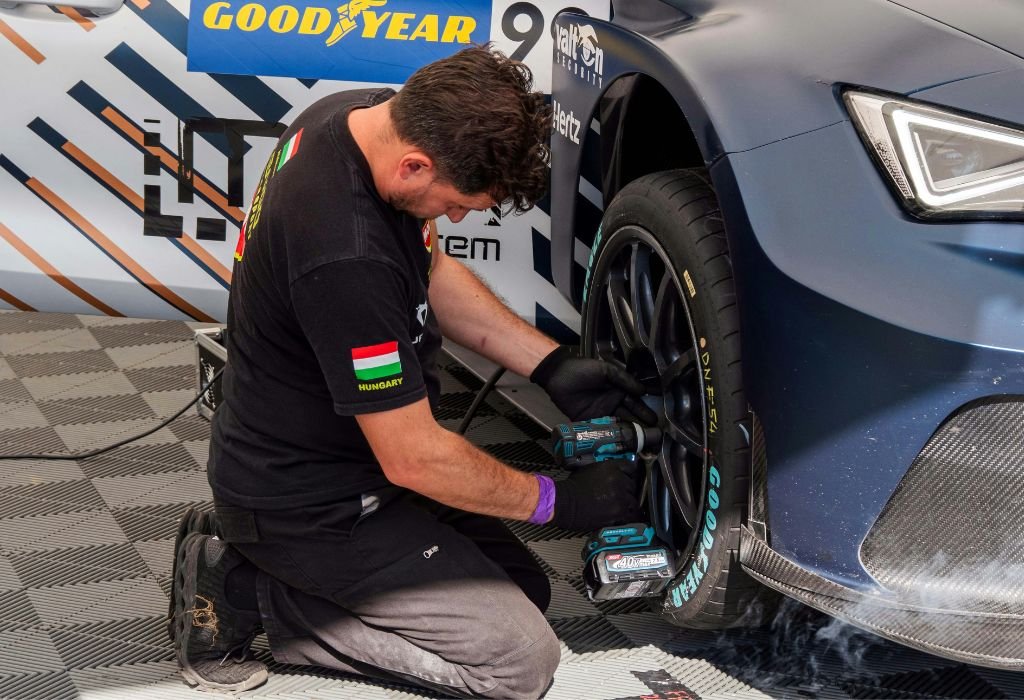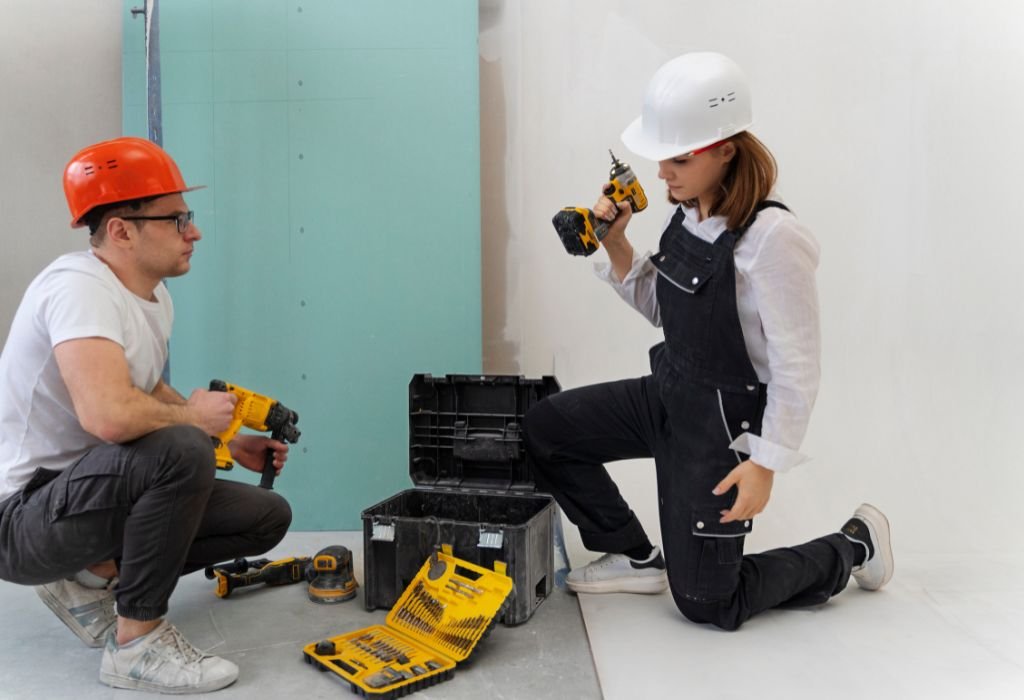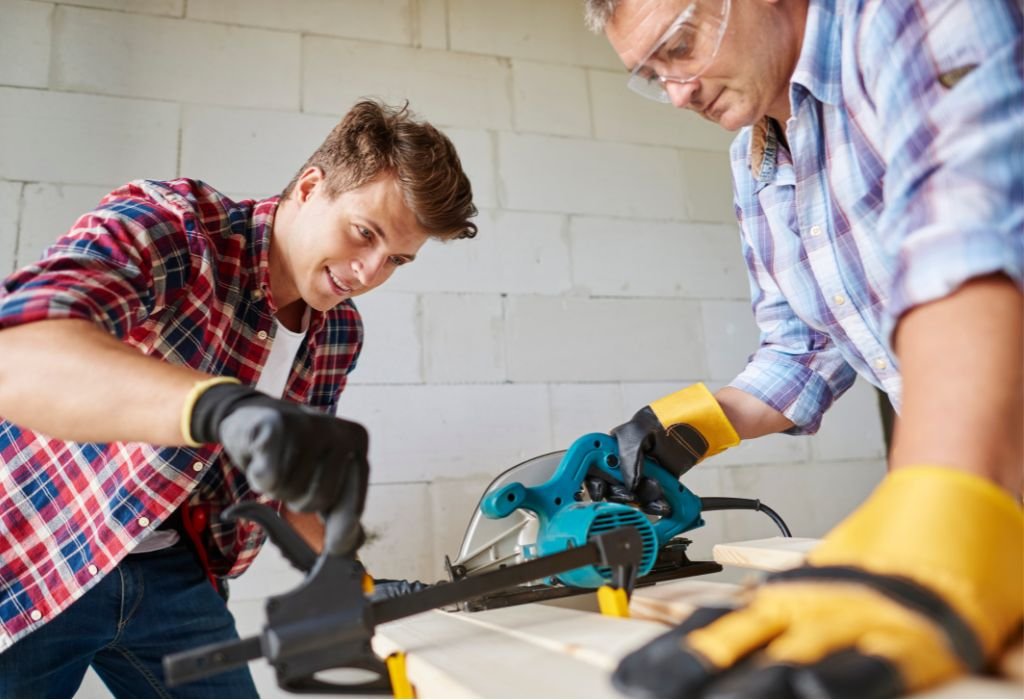Walk into any hardware store and you’ll see drills and impact drivers sitting side by side, looking almost identical.
Yet the truth is, these two tools are built for very different jobs—and using the wrong one can make your project twice as hard.
Research shows that more than 70% of homeowners own a cordless drill, making it the most common power tool in households.
At the same time, professional contractors say that an impact driver can cut fastening time by up to 40% compared to a standard drill.
Still, many DIYers wonder—if they look the same, what’s the real difference between a drill and an impact driver?
In this guide, we’ll break down what each tool does, how they work, their pros and cons, and most importantly, when you should reach for one over the other.
By the end, you’ll know exactly which tool to use for drilling holes, driving screws, or tackling heavy-duty fastening jobs.
What Is a Drill? (Definition & Basics)

A drill is one of the most widely used power tools for both professionals and DIYers. Its primary purpose is to drill holes in various materials like wood, plastic, and metal.
At the front of a drill is a chuck, which securely holds different types of drill bits. Most modern drills feature a keyless chuck, allowing quick bit changes without special tools.
Drills often include adjustable clutch settings to control torque. This prevents overdriving screws and helps protect delicate materials during use.
The variable speed trigger gives users control over how fast the bit spins. Light pressure provides slow speed for precision, while full pressure delivers maximum drilling speed.
Drills come in both corded and cordless models. Cordless drills, powered by lithium-ion batteries, are more popular due to their portability and convenience.
Some drills are compact and lightweight, designed for small jobs and tight spaces. Others are heavy-duty models built for construction and demanding projects.
In short, a drill is a versatile tool that handles a wide range of tasks. From drilling pilot holes to light screwdriving, it’s often the first power tool people buy.
What Is an Impact Driver? (Definition & Basics)
An impact driver is a power tool designed primarily for driving screws and bolts with high torque. It looks similar to a drill but functions very differently.
Instead of a chuck, it uses a ¼-inch hex collet. This collet only accepts hex-shank bits that are strong enough to handle high torque.
The tool uses a hammer-and-anvil mechanism inside. This system delivers short, powerful bursts of torque while still rotating the bit.
These bursts, known as impacts per minute (IPM), provide extra force without requiring much effort from the user. This makes it easier to drive long screws into dense materials like hardwood.
Most impact drivers are cordless and powered by lithium-ion batteries. They are lightweight, compact, and easy to maneuver in tight spaces.
Brushless impact drivers are especially popular among professionals. They run cooler, last longer, and provide more efficient power compared to brushed models.
Unlike drills, impact drivers don’t use adjustable clutches. Instead, they automatically regulate torque, reducing the chance of stripping screws.
In short, an impact driver is a specialist tool built for fastening power. It’s perfect for construction, woodworking, and projects that involve heavy-duty screws and bolts.
Drill vs Impact Driver – Key Differences
The main difference between a drill and an impact driver is how they deliver torque. A drill provides steady, continuous rotation, while an impact driver adds concussive bursts of torque for extra power.
A drill uses a chuck that can hold a variety of round and hex-shank bits. An impact driver uses a ¼-inch hex collet that only accepts hex-shank bits designed for high torque.
When it comes to control, drills feature an adjustable clutch with multiple torque settings. This makes them better for precision work and delicate tasks.
Impact drivers do not have a clutch. Instead, they automatically adjust torque through the hammer-and-anvil mechanism, reducing the chance of stripped screws.
In terms of power, impact drivers produce much higher torque in a compact size. Drills are less powerful but more versatile since they can both drill holes and drive screws.
Noise is another difference. Impact drivers are louder due to their concussive action, while drills operate more quietly.
For user comfort, impact drivers absorb much of the resistance, reducing wrist strain during long fastening jobs. Drills can require more physical effort, especially on tougher materials.
In short, a drill is the all-purpose tool for drilling and light fastening. An impact driver is a specialist tool built for power and heavy fastening.
1. What’s the difference between a drill and an impact driver?
A drill provides steady rotation for drilling holes and light fastening, while an impact driver delivers concussive torque bursts for driving screws and bolts.
2. Can I drill holes with an impact driver?
Yes, but only with hex-shank drill bits. For precise and clean drilling, a standard drill is the better choice.
3. Can I drive screws with a drill?
Yes, drills can drive screws and even have clutch settings to control torque. However, they may struggle with long or tough screws compared to an impact driver.
4. Why are impact drivers louder than drills?
Impact drivers use a hammer-and-anvil mechanism that produces rapid torque bursts, which makes them noisier than drills.
5. Which tool is better for beginners?
A drill is better for beginners since it’s versatile, easy to control, and can handle both drilling and light screwdriving.
6. Which tool is more powerful, drill or impact driver?
Impact drivers produce much higher torque in a compact size, while drills prioritize versatility and precision over raw power.
7. Do impact drivers have a clutch like drills?
No, impact drivers don’t use a clutch. They automatically adjust torque depending on the resistance of the screw or bolt.
8. Are drills more versatile than impact drivers?
Yes, drills are more versatile because they can drill holes and drive screws. Impact drivers are more specialized for fastening.
9. Which tool reduces wrist strain more?
Impact drivers reduce wrist strain because the concussive action absorbs most of the resistance, unlike drills that rely on steady torque.
10. What bits do impact drivers use?
Impact drivers use ¼-inch hex-shank bits designed for high torque. Standard round-shank drill bits won’t fit directly.
11. Can an impact driver replace a drill?
Not entirely—impact drivers excel at fastening, but drills are better for drilling holes with precision. Many people keep both tools.
12. Which is quieter, drill or impact driver?
Drills are quieter because they operate with continuous rotation. Impact drivers are louder due to their internal hammering mechanism.
When to Use a Drill vs Impact Driver (Use Cases)

A drill is the go-to tool when you need to drill holes in wood, plastic, or thin metal. Its steady rotation and clutch settings make it perfect for precision tasks.
Drills are also ideal for light screwdriving jobs such as furniture assembly, cabinetry, or hanging shelves. The adjustable torque prevents damage to materials or overdriven screws.
An impact driver is the better choice for heavy fastening tasks. Driving long screws, lag bolts, or fasteners into hardwood and dense materials is where it shines.
For construction projects like decking, framing, or building fences, an impact driver saves time and reduces fatigue. Its concussive torque keeps bits firmly seated, reducing cam-out and stripped screws.
Impact drivers also work well with automotive projects when paired with a socket adapter. While not as powerful as impact wrenches, they can handle lighter bolts and nuts.
However, if your project involves concrete or masonry, neither tool is ideal. In those cases, a hammer drill is the right choice for drilling into stone or brick.
In summary, use a drill for versatility and precision. Use an impact driver when raw power and efficiency are required.
Pros and Cons of Each Tool
Pros of a Drill
A drill is versatile because it can both drill holes and drive screws. Its adjustable clutch makes it suitable for delicate tasks where precision matters.
Cordless drills are portable and convenient for most home projects. They are also quieter compared to impact drivers.
Cons of a Drill
Drills usually struggle with long screws or dense materials. They require more wrist strength and effort for heavy fastening jobs.
Over time, drills may also strip screw heads if too much torque is applied. This makes them less efficient for large-scale construction work.
Pros of an Impact Driver
Impact drivers provide significantly more torque in a compact size. They make driving long screws and bolts faster and easier.
Their hammer-and-anvil mechanism reduces wrist strain. They also prevent cam-out, keeping bits firmly seated in screw heads.
Cons of an Impact Driver
Impact drivers are louder than drills and can be uncomfortable to use indoors without ear protection. They also lack clutch settings for precise torque control.
They require ¼-inch hex-shank bits, which limits versatility compared to a drill’s chuck. While they can drill holes, they are not ideal for accurate or clean drilling.
Choosing the Right Tool for Your Needs

The choice between a drill and an impact driver depends on the type of projects you plan to handle. For everyday home tasks, a drill is usually the more practical and versatile option.
If you often work with long screws, lag bolts, or dense materials, an impact driver will save you time and effort. Its high torque makes it ideal for heavy-duty fastening jobs.
Consider the motor type when buying—brushless models run cooler, last longer, and use power more efficiently than brushed ones. While more expensive, they’re worth the investment for frequent use.
Think about cordless vs corded models. Cordless tools offer portability, while corded versions provide consistent power for longer sessions.
Pay attention to battery voltage and capacity if you choose cordless. A 12V tool is great for light DIY, while 18V or 20V models deliver more power for professional work.
Finally, many professionals recommend owning both tools. The drill handles drilling and light fastening, while the impact driver takes on tougher screws and bolts with ease.
1. Do I really need both a drill and an impact driver?
Not always—casual DIYers can start with a drill. Professionals often keep both because they complement each other’s strengths.
2. Which tool is better for woodworking?
A drill is best for drilling pilot holes and precision work. An impact driver is better for fastening long screws into hardwood.
3. Which is easier to use in tight spaces?
Impact drivers are usually more compact and lighter, making them easier to handle in confined areas.
4. Can an impact driver replace a hammer drill?
No, impact drivers are not designed for masonry. A hammer drill is required for concrete, brick, or stone.
5. Are impact drivers safe for beginners?
Yes, impact drivers are beginner-friendly since they automatically regulate torque. However, their noise level may take some getting used to.
6. Why do drills have a clutch but impact drivers don’t?
A clutch on a drill provides torque control for precision. Impact drivers rely on their hammer-and-anvil mechanism to adjust torque automatically.
7. Can you use regular drill bits in an impact driver?
No, impact drivers only accept ¼-inch hex-shank bits. Using standard drill bits requires a special adapter.
8. Which tool is more battery-efficient?
Brushless impact drivers are often more energy-efficient under heavy loads. For light use, drills consume less power.
9. Which tool causes less fatigue over long use?
Impact drivers reduce wrist strain because the torque is absorbed by the hammer mechanism. Drills can be tiring during heavy fastening jobs.
10. What’s the lifespan difference between drills and impact drivers?
Both can last for years with proper care, but impact drivers tend to experience more stress because of their high torque use.
11. Which tool should I buy first as a DIY beginner?
A drill is the smarter first purchase. It’s versatile, beginner-friendly, and can handle most home projects.
12. Are impact drivers always more expensive than drills?
Not always—basic impact drivers can be affordable. However, brushless or pro-grade impact drivers usually cost more than entry-level drills.
Conclusion
Drills and impact drivers may look alike, but their functions are very different. One focuses on versatility and precision, while the other delivers power and speed for heavy fastening.
A drill is the right choice for drilling holes, light screwdriving, and general DIY projects. An impact driver is the better option for driving long screws, lag bolts, and working with dense materials.
If you’re just starting out, a drill should be your first purchase. If you handle more demanding projects, adding an impact driver to your toolkit will make your work faster and easier.
Ultimately, having both tools ensures you’re prepared for any job. By choosing the right tool, you’ll save time, reduce strain, and get better results every time.

I’m John F. Nicholas, the founder, lead writer, and drill enthusiast behind 101drill.com. With years of hands-on experience in power tools and DIY projects, I created this platform to share practical knowledge, expert tips, and real-world insights to help others master the art of drilling.
